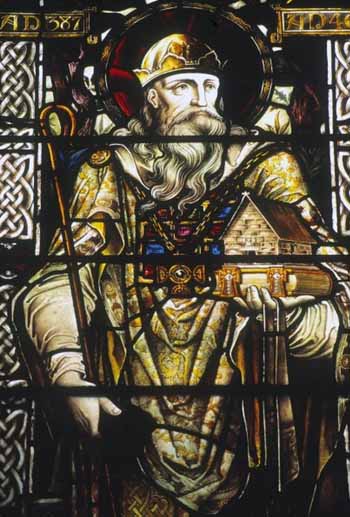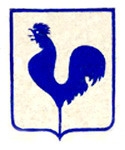 |
Stories & Legends
A Last Vision of St. Patrick
Fr. William B. Morris
Not only did the conversion of the Irish people to Christianity take place with extraordinary rapidity, but to this first grace God added another almost as great: that is, the long presence of the great Patriarch with his children. Other Apostles have had to leave their work to be finished by lesser men, but for 59 years after the power of paganism had been broken at Tara, St. Patrick held undisputed sway as Pontiff and Teacher of the Church in Ireland. He lived long enough to see the grey hairs on the heads of those whom he had baptized as children, so that he had time to organize and consolidate that infant Church, and to create a native clergy.

St. Patrick left an endurings mark on the whole Church in Ireland |
The evidence on this point in St. Patrick must, as usual, be extracted from detached sentences from his writings. He alludes to the thousands of men (tota millia hominum) whom he had baptized. “Greatly am I in debt to God, who has given me such grace that great multitudes are, by my ministry, born to God, and then confirmed. And that for this people whom the Lord hath taken, coming to the faith in those latter days, clerics everywhere were ordained." (Conf.,c.IV,§18.)
There seems to be no doubt that St. Patrick retired from the government of the See of Armagh many years before his death, probably in 455, and during the long interval between that period and his own death he saw four Bishops successively fill that see. Sixty years of ecclesiastical rule in Ireland gave St. Patrick time, not only to teach the faith, but to establish traditions.
The rulers of the Church during this long period were his own spiritual children, so while one generation passed away, and another succeeded, there was no change or disturbance in the life of that Church, which had all its organization and discipline, as well as its doctrines, from one man. The same prodigious power, which in the beginning had broken all opposition, preserved unity and peace when the struggle was over, and made the fold of St. Patrick like the infant Church in Judaea, when "the multitude of believers were of one heart and one mind." ....
The latter years of the Saint's life were spent for the most part at Saul or Armagh, where in retirement he held communion with God, and again tasted the ineffable joys of his youth, when his soul was espoused to God in solitude on Slemish during his captivity on the emerald island. The Last Day alone will reveal the lights then given to him, and the graces that he obtained for his children.
Once the Saint had a great vision, in which the actual state and the future of the Church in Ireland were revealed to him. In the first place, he saw the whole land, as it were, like a great furnace whose flames reached to the sky. And he clearly heard the voice of an Angel saying, "Such is now - the state of Ireland in the sight of the Lord."
After a little time, instead of this far-spreading universal fire, he saw flaming mountains here and there over the land, then torches shining, succeeded by glimmering lights amidst an ever-increasing darkness. Last of all, he saw a few live coals buried and burning deep in the earth. Then an angelic voice was heard, saying that such should be the successive states of the Irish people in times that were coming.
Then, with tears rolling down his cheeks, the Saint repeated many times those words of the Psalmist, "Will God then cast us off forever? Or will He never more be favorable again? Or will He cut off His mercy forever from generation to generation? Or will God forget to show mercy? Or will He in anger close off His mercies?"
The Angel answered and told him to look to the north of the land, and that there he should see the Hand of the Most High. The Saint lifted up his eyes, and, behold, a little light arose in Uladh (Ulster), which had struggled long in the darkness, until at length the whole island was filled with the brightness of its glory, and Ireland returned to its first state of all-pervading fire. (Acta SS., p. 575).
At the time when Jocelyn wrote this in the 12th century, conflicting interpretations of this vision were prevalent. The days of darkness were taken by some to be the terrible time of the Danish persecution in the 9th century. The light that began in Ulster was thought by some to signify the figure of the great St. Malachy, first Bishop of Down in Ulster and Legate of the Holy See under Innocent II, whose life and labors were recorded by his friend St. Bernard. The English invaders boldly asserted that the light was a figure of the state of things that they had introduced. Jocelyn himself abstained from giving any opinion on the subject.

Excerpt from The Life of Saint Patrick, Apostle of Ireland
William B. Morris, London/NY: Burns & Oates Lmtd, 1890
Posted March 16, 2012


Related Topics of Interest
 St. Patrick Apostle of Ireland St. Patrick Apostle of Ireland
 St. Patrick’s Breastplate & Resurrections St. Patrick’s Breastplate & Resurrections
 Honor, a Counter-Revolutionary Virtue Honor, a Counter-Revolutionary Virtue
 Discerning the Historic Roles of Nations Discerning the Historic Roles of Nations
 Vocations of the European Peoples Vocations of the European Peoples
 The Fidelity of the Remnant Throughout History The Fidelity of the Remnant Throughout History

Related Works of Interest
| |
|
Legends | Religious |
Home | Books | CDs | Search | Contact Us | Donate

© 2002-
Tradition in Action, Inc. All Rights Reserved
|
 |
|